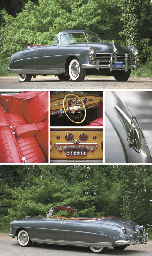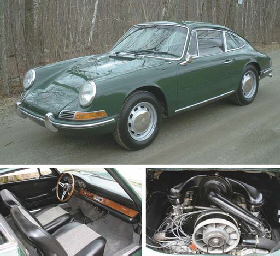1909 CHALMERS-DETROIT THIRTY TOURING
1909 CHALMERS-DETROIT THIRTY TOURING Engine No.: K12889 Royal Blue with maroon chassis, tan canvas top and black leather interior Engine: inline four-cylinder, F-head, 225.6 ci.; Gearbox: 3 speed manual; Suspension: semi-elliptic front, three-quarters elliptic rear; Brakes: contracting on transmission, expanding on rear wheels. Right hand drive. The story of the Chalmers Motor Company is a complex one, and includes many of well-known names in the U.S. auto industry, including Roy Chapin, Erwin Ross Thomas Ransom Olds and Howard Coffin. Starting in 1901 when Chapin began work with Olds and was joined by Coffin, they worked together until Olds left his company in 1905. Meanwhile, Thomas had been building cars under his name in Buffalo, New York and Chapin and Thomas saw an opportunity to leave the Olds company and manufacture Thomas' cars in Detroit, calling them Thomas-Detroit. Commencing the operation in 1906, they had a success, but soon decided they wanted to build a car of their own. Enter Hugh Chalmers, at the time the Vice President of the National Cash Register Company. Chapin and Thomas arranged for Chalmers to buy out Thomas' interest in the company they were running and join them as president of what would now be called the Chalmers-Detroit company in 1908. They remained restless, however and two years later left this new firm to start building Hudson cars. With their departure in the second half of 1910, Chalmers renamed the company, dropping the "Detroit" and becoming simply "Chalmers". The Chalmers cars had become popular and successful medium-priced cars, setting records including a 32,000 mile run from Denver to Mexico City in 1909 and winning the Glidden Trophy two years running in 1910 and 1911. Self starters became standard in 1912 and for more than ten years Chalmers were among the best selling automobiles in the U.S. Following World War I, the company was merged with Maxwell and by 1924 manufacture of Chalmers cars came to an end. Maxwell had been taken over by Walter P. Chrysler and the following year saw that marque also disappear, its products becoming Chryslers. In 1909, Chalmers-Detroit offered two models, the "Thirty", a 4-cylinder 30 horsepower chassis with a 110" wheelbase and the 40 horsepower 4-cylinder "Forty" on a 112" in wheelbase. The Thirty was marketed as a lower-priced alternative to the larger model and much was made of its reasonable price, $1,500 for the roadster model in 1910. Such was the popularity of the Chalmers-Detroit that they stated in an ad in the July 7, 1909 issue of "The Horseless Age" that they were showing their 1910 models in July, so "the 800 people disappointed in not getting the 1909 models can secure the new cars four or five months before the calendar year begins." The Thirty Touring Christie's presents here is of course a car produced prior to the name change. Although the Thirty was the "small" offering from the company, it is nevertheless a large and impressive automobile. Formerly in the collection of the late Samuel Flohr of Colorado, it was in fact the very car with which he earned the first of his many AACA wins with a 1st National in 1984. It has a handsome open touring body with abundant brass trim including original Atwood-Castle gas headlights, bearing the legend "made for Chalmers-Detroit" and twin cowl mounted sidelamps. These Chalmers-Detroit cars are known to be lively performers and this one would be an ideal participant in brass era tours following a mechanical re-commissioning. With the elegant Royal Blue finish, set off with cream coach lining and the beautifully finished dash bulkhead wood, this Chalmers-Detroit Thirty Touring would, with a bit of freshening, be ready to once again take its place of honor on the concours lawn.
1909 CHALMERS-DETROIT THIRTY TOURING
1909 CHALMERS-DETROIT THIRTY TOURING Engine No.: K12889 Royal Blue with maroon chassis, tan canvas top and black leather interior Engine: inline four-cylinder, F-head, 225.6 ci.; Gearbox: 3 speed manual; Suspension: semi-elliptic front, three-quarters elliptic rear; Brakes: contracting on transmission, expanding on rear wheels. Right hand drive. The story of the Chalmers Motor Company is a complex one, and includes many of well-known names in the U.S. auto industry, including Roy Chapin, Erwin Ross Thomas Ransom Olds and Howard Coffin. Starting in 1901 when Chapin began work with Olds and was joined by Coffin, they worked together until Olds left his company in 1905. Meanwhile, Thomas had been building cars under his name in Buffalo, New York and Chapin and Thomas saw an opportunity to leave the Olds company and manufacture Thomas' cars in Detroit, calling them Thomas-Detroit. Commencing the operation in 1906, they had a success, but soon decided they wanted to build a car of their own. Enter Hugh Chalmers, at the time the Vice President of the National Cash Register Company. Chapin and Thomas arranged for Chalmers to buy out Thomas' interest in the company they were running and join them as president of what would now be called the Chalmers-Detroit company in 1908. They remained restless, however and two years later left this new firm to start building Hudson cars. With their departure in the second half of 1910, Chalmers renamed the company, dropping the "Detroit" and becoming simply "Chalmers". The Chalmers cars had become popular and successful medium-priced cars, setting records including a 32,000 mile run from Denver to Mexico City in 1909 and winning the Glidden Trophy two years running in 1910 and 1911. Self starters became standard in 1912 and for more than ten years Chalmers were among the best selling automobiles in the U.S. Following World War I, the company was merged with Maxwell and by 1924 manufacture of Chalmers cars came to an end. Maxwell had been taken over by Walter P. Chrysler and the following year saw that marque also disappear, its products becoming Chryslers. In 1909, Chalmers-Detroit offered two models, the "Thirty", a 4-cylinder 30 horsepower chassis with a 110" wheelbase and the 40 horsepower 4-cylinder "Forty" on a 112" in wheelbase. The Thirty was marketed as a lower-priced alternative to the larger model and much was made of its reasonable price, $1,500 for the roadster model in 1910. Such was the popularity of the Chalmers-Detroit that they stated in an ad in the July 7, 1909 issue of "The Horseless Age" that they were showing their 1910 models in July, so "the 800 people disappointed in not getting the 1909 models can secure the new cars four or five months before the calendar year begins." The Thirty Touring Christie's presents here is of course a car produced prior to the name change. Although the Thirty was the "small" offering from the company, it is nevertheless a large and impressive automobile. Formerly in the collection of the late Samuel Flohr of Colorado, it was in fact the very car with which he earned the first of his many AACA wins with a 1st National in 1984. It has a handsome open touring body with abundant brass trim including original Atwood-Castle gas headlights, bearing the legend "made for Chalmers-Detroit" and twin cowl mounted sidelamps. These Chalmers-Detroit cars are known to be lively performers and this one would be an ideal participant in brass era tours following a mechanical re-commissioning. With the elegant Royal Blue finish, set off with cream coach lining and the beautifully finished dash bulkhead wood, this Chalmers-Detroit Thirty Touring would, with a bit of freshening, be ready to once again take its place of honor on the concours lawn.















Testen Sie LotSearch und seine Premium-Features 7 Tage - ohne Kosten!
Lassen Sie sich automatisch über neue Objekte in kommenden Auktionen benachrichtigen.
Suchauftrag anlegen